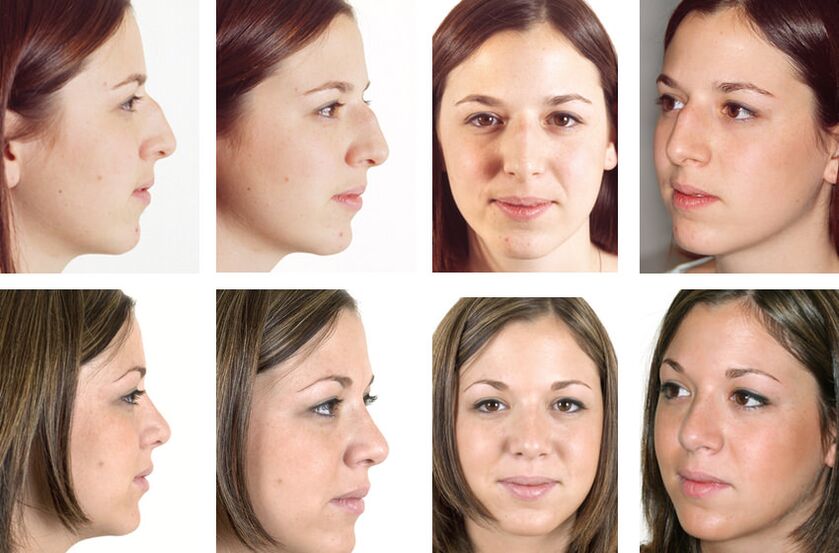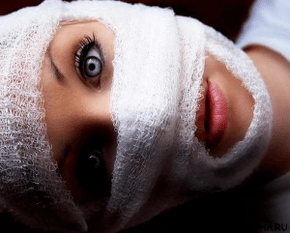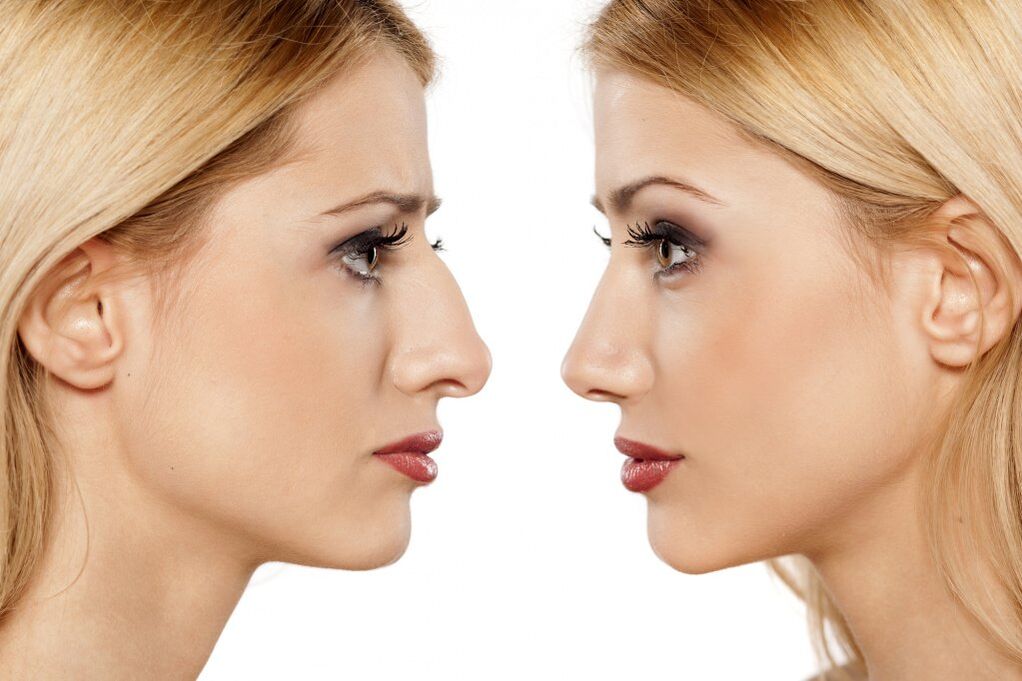Rinoplasty is a special surgical operation that is carried out to correct congenital or acquired nasal defects and to increase the lack of the missing parts of the nose.
The operation of the nose correction lies in the fact that the surgeon changes the nasal parameters by invasion of the nose-bone chryash frame.
The main task of such an operation is to return the correct shape of the nose to a person who was injured before birth due to the diseases or by the acquired nostril.

Types of nasal corrections
Today the world uses such types of rinoplasty of the nose:
- Septoplasty;
- closed nose correction;
- Open nose correction;
- Nasal correction in secondary behavior;
- Nasal correction without surgery;
- Nasal correction when using fillers;
- Nasal correction with special auxiliary medication;
- Rinoplastics with aptos threads.
Septoplasty
Septoplasty is a surgical intervention that is the task of eliminating defects in the nasal septum - the shift of cartilage and bones that affect the normal functions and the aesthetic type of nose.
Indications for Septoplasty for people:
- Constant nasal congestion for no obvious reason;
- snoring;
- Nose development errors or nose partitions;
- constant or periodic nose bleeding;
- the presence of chronic sinusitis;
- General deformation of the nose;
- The consequence of the nose injury, which prevents the normal breathing function.
Contraindications to Septoplasty:
- the presence of diabetes;
- Too much distortion of the nasal septum;
- The presence of diseases of the cardiovascular system.
Closed nose correction
A closed nose correction as an operation is more easily tolerated by a patient than an open nose correction. This procedure is carried out by the endonasal access to the nose, ie the cuts are made directly in the nose.
This operation has a number of advantages for the patient, but is extremely impractical for the surgeon, as it is easier for every surgeon to carry out an operation on a well -accessible company area. Accordingly, there is much more chances of receiving a medical mistake in closed rhinos, which is why complications or other problems in the patient can occur.
Advantages of closed nose correction:
- The duration of the company is much lower compared to an open nose correction.
- Nose tissue are not cut on the surface of the nose and the cuts of smaller size.
- less likely with the appearance of scars;
- smaller edema after the operation;
- The result of the operation is visible a few days earlier.

Indications for closed nose corrections:
- Aesthetics (curve, ugly shape of the nose, deformation of the nose, etc. );
- Medical (nasal injury, respiratory arrest due to the wrong structure of the nose).
Contraindications for this type of operation:
- the presence of mental illnesses in the patient;
- Inadequacy of the wishes of the patient's end result;
- The presence of diseases in which a nose correction is contraindicated;
- The implementation of several unsuccessful rhinos by the patient earlier, who strongly deformed the soft tissue of the nose.
Since closed nose correction is a rather complicated operation, the patient can have the following complications after his behavior:
- Inflammation of the nasal tissue;
- the formation of scars (rare);
- the formation of pigmentation on the skin that can remain forever;
- Bleeding;
- Nose bleeding;
- Swelling or hematoma around the nose;
- Wrong nose form for which a secondary operation is required.
Open nose correction
In contrast to a closed, open nose correction is carried out with a small cut with a diameter of 4 to 5 mm. Thanks to such a visible section, the nasal skin can be fully raised, and then the surgeon will work much more conveniently with an open nasal skeleton, since in contrast to closed rhinos in front of it, it will see the entire outer structure of this organ. This significantly reduces the opportunities of a surgical error.
In addition, an open nose correction is recommended for primary surgery, since in contrast to the closed nasal correction, it can remove all existing nasal defects more precisely, which cannot always guarantee the same result.
Rinoplasty on secondary behavior
A secondary nose correction is carried out if the primary was unsuccessful and it is necessary to correct the complications. It can be closed both open and closed.
Rinoplasty without surgery
Rinoplasty without surgery is only carried out in 4-7 % of the patients who can do without surgery. With their help, only smaller nasal errors can be corrected. More serious problems in the structure and appearance of the nose only require a complete nose correction company.
Rinoplasty when using fillers
This procedure is carried out if the patient only wants to eliminate smaller nose defects. This can be, for example, various minor disadvantages, defects, expansion of the tip of the nose, the falsehood of its symmetry, etc. In these cases, doctors use special fillers that are inserted into the nasal tissue and correct the problem.
The advantages of this method is that the restoration of the nose is much easier after this and the process itself is not as painful as ordinary surgical intervention.
The disadvantages of nasal correction with fillers are a change in the structure of the nose tissue and the possible "migration" on the nose of the nose of the drug administered.
Nasal correction with special auxiliary medication
In order to carry out such a procedure, surgeons use special medicines based on hormones that are inserted into defective nasal zones.
The advantage of such a nose correction is that the patient is not exposed to surgical intervention. However, a major disadvantage of such a nose correction is that the patient can have different complications and deterioration of defects with the improper calculation of the dose of the drug and its introduction to the wrong area in the nose.

Nasal correction with threads
This process is carried out with threads with which doctors pull the nasal and nose wings. These threads stand by special punctures in the nose and pull their noses up, so to speak.
Rinoplastics with threads are not used very often by surgeons because it has a number of disadvantages:
- After the procedure, there is a great probability of the formation of scars;
- the occurrence of contours and the ugly type of nose in "points";
- The high probability of a break in the threads, since the nose is very mobile in its structure, which ensures the unreliability of this procedure.
Advantages and disadvantages of nose correction
The plus points of the nose correction:
- Satisfaction with its appearance after the operation;
- the complete elimination of defects in a successfully carried out procedure;
- Improvement of breathing in preoperative disorders.
Disadvantages of nose correction:
- the possibility to acquire an infection;
- Loss of sensitivity to nose;
- Bleeding;
- unsuccessful operation, complications;
- Determination of the occurrence of the nose and dissatisfaction with the end result.
Indications and contraindications
If a person has innate nose defects, but can do a nose correction with the beginning of adulthood. In general, the age of 18 to 40 years is considered the most suitable age for this procedure if the body has already been formed and a person makes a balanced decision.
Indications for nose correction:
- the presence of a hump in the nose;
- Congenital nasal errors;
- Nasal errors that were acquired by injuries;
- Violation or full impossibility to breathe with his nose;
- Nostrils of too wide volume;
- The nose is too long;
- Nose in the form of a crumpled saddle;
- Nose of the hook -like addition;
- too thick nose;
- Too sharp nose.
Contraindications for nose correction:
- Human minority (if the injury was acquired as a child, the procedure is possible in premature lines);
- Age after the fortest anniversary (since this age a person has the risk of all types of complications and worsens the healing process of wounds).
- the presence of diabetes mellitus;
- All types of kidney or liver diseases;
- Problems with the patient's blood clotting;
- Serious heart disease and blood vessels;
- Acute virus diseases;
- The presence of oncological diseases;
- The presence of mental disorders;
- If there are no nasal errors and nose corrections are simply not required.
Preparation for nose correction
Since the nose correction is a complete operation for some time, the patient should carry out the following:
- Examination of a full exam for cardiovascular diseases.
- If you pass the investigations and advise the therapist, neuropathologist, Laura, anesthetist, surgeon who will carry out the operation, etc.
- In order to discuss all possible consequences of the company with the surgeon and to determine the future form of the nose, the width, etc. , the type of anesthesia must also discuss with an anesthetist that he will use during operation.
- There are all necessary tests.

Implementation of operations - levels
Rinoplastics are carried out in these phases:
- Anesthesia is administered to the patient;
- Additional anesthesia is carried out;
- After that, the surgeon makes a cut in the lower nose cover and begins with its work (such surgical intervention can be both closed and open).
- The surgeon adapts all nasal errors, corrects irregularities, humps, etc. depending on the specific problem of the patient.
- If necessary, he can replace the carts that are missing in the nose from his other zones or implanted artificial cartilage.
- After completing the operation, the surgeon sews its nose and lists a fastening band.
Depending on the complexity and the course of the procedure, the operation of the nose correction can take 50 minutes to 2 hours. It should also be mentioned that the nose can be subjected to independent changes in the form of improvements or deterioration after the operation.
All of this depends on the patient, his compliance with medical recommendations and directly on the results of the operation itself, which are only visible after 6-8 months.
Rehabilitation period
After a nose correction, in the nose and in the region, swelling and hematomas are formed, which normally go in two weeks. After the operation, a special fixing tape is applied to the patient's nose, which must be worn within ten days. Tampons are also inserted into the nose, which prevents bleeding, so that the patient is unable to breathe the nose for some time.
The result of the company can be assessed in six months and the end result is in one year. The delay of the wounds after the operation depends on each person individually and on the condition of his vitality. If complications are observed after the operation, the healing lines can increase significantly.
After a nose correction, it is desirable to visit your surgeon to carry out inspections of the nose inspections after nasal correction.
Recommendations before and after the operation
The patient follows before the operation:
- Put on all bad habits (alcohol, fat foods, etc. );
- Medicines and products are prohibited a few days before the operation, which causes a reduction in blood clotting in the body.
After the operation, the patient must meet the following requirements:
- In the first few months after nasal correction you cannot drive yourself to sports (gymnastics, running, etc. ).
- It is undesirable to swim;
- Don't eat too hungry or hot food to avoid bleeding.
- Wash carefully without touching your nose and zones around it;
- Avoid a sharp change in facial treatment with facial authorities.
- Wear the clothes that do not have to be removed over your head.

Possible complications after the operation
The following complications can occur after nasal correction or during the procedure itself:
- Allergy to anesthesia.
- Expensive nosebleeds.
- The edema of the nose zone (in the first weeks after the procedure), which can affect normal nasal breathing.
- Swelling on the face (in the eyes, cheeks and other parts of the face).
- The appearance of hematoma on the face.
- Reduction of the sensitivity of the skin of the nose or its absolute loss for a while.
- The risk of infection infection.
- Large scars can form to remove that a different operation is required.
- Difficult breathing after the operation (depending on the type of operation and the procedure). Which are carried out with nasal norp.
- The occurrence of the odor or partial loss.
- Stretching of the skin or loss of its flexibility (with excessive cutting cartilage in the nose).
- Narrow tissue.
- The formation of age spots or the manifestation of blood vessels on the skin of the face.
- Fatal result with anaphylactic shock.
- Patient satisfaction with the end result of the procedure.
- Unsuccessful course of the procedure by the surgeon's debt.
Results
The first results of the company are visible after 10 to 14 days. But the patient can only see the end result after 8-10 months if all numerous edema and bruises leave and "lay down" the fabrics on the new nose.
It often happens that relatives and friends do not notice any significant changes in the appearance of the patient after the operation. Because hematoma and swelling drown out the entire result. In this case, the patient does not have to go to the repeated nose correction immediately, but it should only be expected if the face comes into the usual form and then evaluates the end result.
It should also be pointed out that nose correction has no genetic effect and is not transmitted by the clan for children how some patients can take into account. This operation only improves the appearance of a person.






















